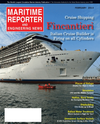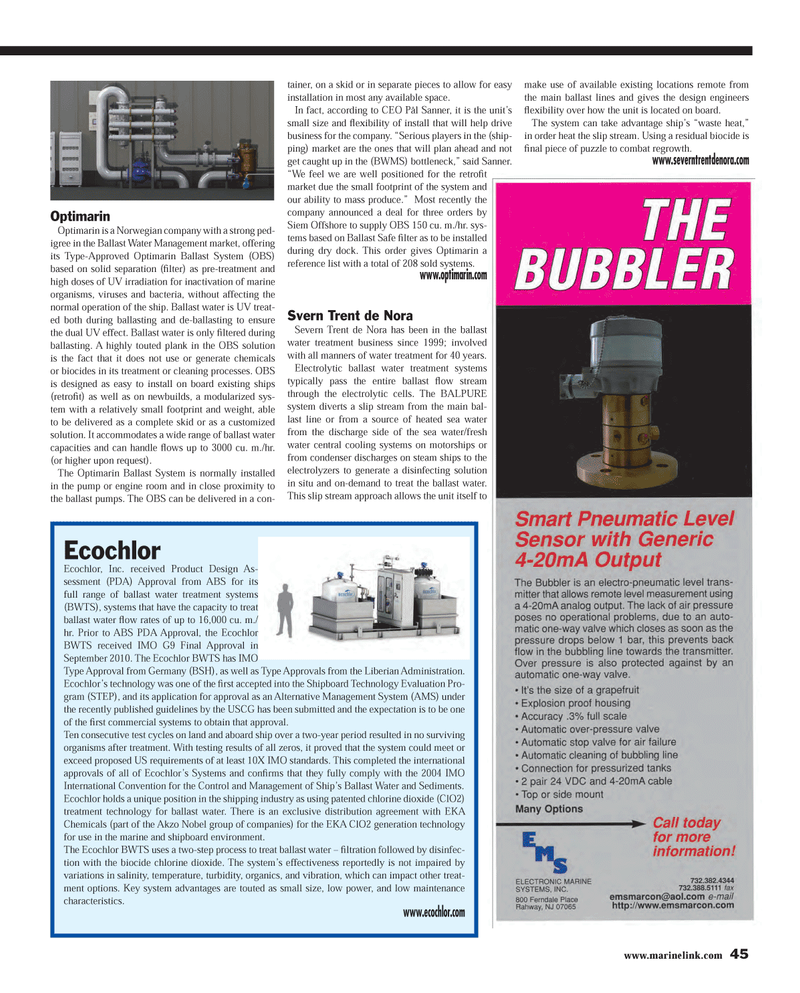
Page 45: of Maritime Reporter Magazine (February 2013)
Cruise & Passenger Vessel
Read this page in Pdf, Flash or Html5 edition of February 2013 Maritime Reporter Magazine
www.marinelink.com 45Optimarin Optimarin is a Norwegian company with a strong ped-igree in the Ballast Water Management market, offering its Type-Approved Optimarin Ballast System (OBS) based on solid separation (Þ lter) as pre-treatment and high doses of UV irradiation for inactivation of marine organisms, viruses and bacteria, without affecting the normal operation of the ship. Ballast water is UV treat- ed both during ballasting and de-ballasting to ensure the dual UV effect. Ballast water is only Þ ltered during ballasting. A highly touted plank in the OBS solution is the fact that it does not use or generate chemicals or biocides in its treatment or cleaning processes. OBS is designed as easy to install on board existing ships (retroÞ t) as well as on newbuilds, a modularized sys- tem with a relatively small footprint and weight, able to be delivered as a complete skid or as a customized solution. It accommodates a wide range of ballast water capacities and can handle ß ows up to 3000 cu. m./hr. (or higher upon request).The Optimarin Ballast System is normally installed in the pump or engine room and in close proximity to the ballast pumps. The OBS can be delivered in a con- tainer, on a skid or in separate pieces to allow for easy installation in most any available space. In fact, according to CEO Pål Sanner, it is the unit?s small size and ß exibility of install that will help drive business for the company. ?Serious players in the (ship- ping) market are the ones that will plan ahead and not get caught up in the (BWMS) bottleneck,? said Sanner. ?We feel we are well positioned for the retro Þ t market due the small footprint of the system and our ability to mass produce.? Most recently the company announced a deal for three orders by Siem Offshore to supply OBS 150 cu. m./hr. sys- tems based on Ballast Safe Þ lter as to be installed during dry dock. This order gives Optimarin a reference list with a total of 208 sold systems. www.optimarin.com Svern Trent de Nora Severn Trent de Nora has been in the ballast water treatment business since 1999; involved with all manners of water treatment for 40 years. Electrolytic ballast water treatment systems typically pass the entire ballast ß ow stream through the electrolytic cells. The BALPURE system diverts a slip stream from the main bal-last line or from a source of heated sea water from the discharge side of the sea water/fresh water central cooling systems on motorships or from condenser discharges on steam ships to the electrolyzers to generate a disinfecting solution in situ and on-demand to treat the ballast water. This slip stream approach allows the unit itself to make use of available existing locations remote from the main ballast lines and gives the design engineers ßexibility over how the unit is located on board.The system can take advantage ship?s ?waste heat,? in order heat the slip stream. Using a residual biocide is Þ nal piece of puzzle to combat regrowth. www.severntrentdenora.com EcochlorEcochlor, Inc. received Product Design As- sessment (PDA) Approval from ABS for its full range of ballast water treatment systems (BWTS), systems that have the capacity to treat ballast water ß ow rates of up to 16,000 cu. m./ hr. Prior to ABS PDA Approval, the Ecochlor BWTS received IMO G9 Final Approval in September 2010. The Ecochlor BWTS has IMO Type Approval from Germany (BSH), as well as Type Approvals from the Liberian Administration. Ecochlor?s technology was one of the Þ rst accepted into the Shipboard Technology Evaluation Pro- gram (STEP), and its application for approval as an Alternative Management System (AMS) under the recently published guidelines by the USCG has been submitted and the expectation is to be one of the Þ rst commercial systems to obtain that approval. Ten consecutive test cycles on land and aboard ship over a two-year period resulted in no surviving organisms after treatment. With testing results of all zeros, it proved that the system could meet or exceed proposed US requirements of at least 10X IMO standards. This completed the international approvals of all of Ecochlor?s Systems and con Þ rms that they fully comply with the 2004 IMO International Convention for the Control and Management of Ship?s Ballast Water and Sediments. Ecochlor holds a unique position in the shipping industry as using patented chlorine dioxide (ClO2) treatment technology for ballast water. There is an exclusive distribution agreement with EKA Chemicals (part of the Akzo Nobel group of companies) for the EKA ClO2 generation technology for use in the marine and shipboard environment. The Ecochlor BWTS uses a two-step process to treat ballast water ? Þ ltration followed by disinfec- tion with the biocide chlorine dioxide. The system?s effectiveness reportedly is not impaired by variations in salinity, temperature, turbidity, organics, and vibration, which can impact other treat- ment options. Key system advantages are touted as small size, low power, and low maintenance characteristics.www.ecochlor.com MR #2 (42-49).indd 45MR #2 (42-49).indd 452/3/2013 1:15:52 PM2/3/2013 1:15:52 PM

 44
44

 46
46
